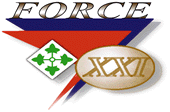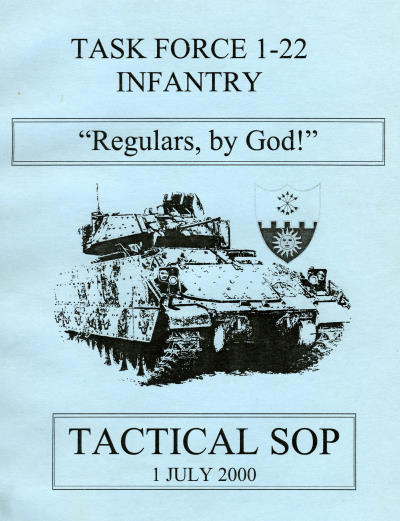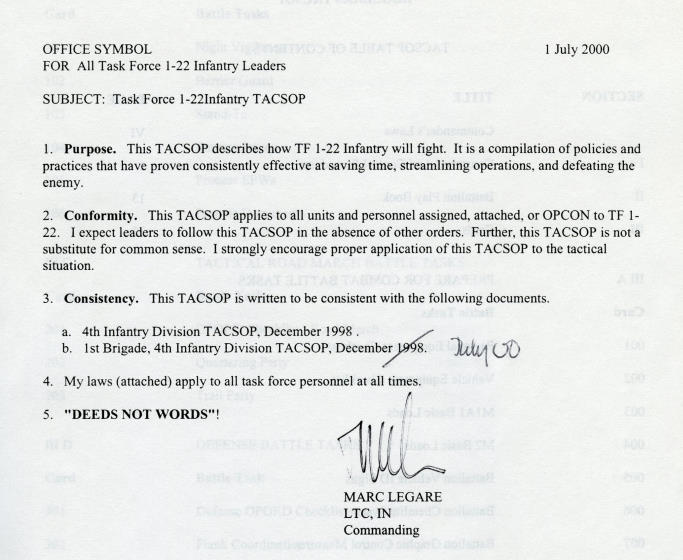![]() 1st Battalion 22nd Infantry
1st Battalion 22nd Infantry ![]()
August 2000
Report on the Battalion's time at the National Training Center
by LTC Marc Legare


LIFE FOR THE 1-22 SOLDIERS AT THE NTC
The training at the National Training Center (NTC) consists of deploying the Brigade Combat Team (BCT) to the NTC. The scenario is that the USA is assisting the democratic, freedom-loving people of Mojavia from the warlike Krasnovians.
The deployment and training is designed to make this as realistic as possible to stress and train all the systems of the brigade, just like a real life deployment to a combat theater of operations. The operation is organized into five phases: Deployment, Combat Power Generation, Combat, Combat Power Regeneration, and Redeployment. Remember that the 1-22 is now "task organized." This means that A Co is now working with 3-66 Armor and C/3-66 Armor is now with 1-22. Also, A/299 Engineers fights with 1-22. But for FRG purposes, all 1-22 families stay together.
Deployment started on 31 July and will conclude on 12 August. All the digitally equipped fighting vehicles (Tanks and Bradleys) were rail-loaded on trains. For this rotation, almost everything that had digital equipment was rail-loaded to the NTC (versus drawing "regular" vehicles from the fleet at NTC - thus simulating drawing POMCUS (prepositioned equipment configured in unit sets). Some light-wheeled vehicles like the HMMWVs (High Mobility Multi-purpose Wheeled Vehicles) got there via US Air Force planes.
The majority of our soldiers deployed on chartered civilian aircraft. Flights went into Southern California International Logistic Airport. This airport is a former Air Force Base that has been converted to co-use (just like Robert Gray Army Airfield). Busses then picked up the soldiers and transported them to Ft Irwin (alias Irwin Military City). The rail-load trains are staged in the town of Yermo. The vehicles are downloaded and driven (if wheeled) or put on trucks (if tracked) and hauled to IMC. Once everyone is in IMC with equipment, the deployment is complete and Combat Power Generation starts.
In IMC, the Brigade Combat Team (BCT) must draw additional equipment and bring all equipment to full military capability. This phase lasts from 13 August to 19 August. For the BCT this means reestablishing digital communications, repacking soldier equipment, drawing trucks, radios, tools, etc from the "POMCUS" and performing selected training events. Also, since the unit is in a potential combat theater, its bivouac site must be prepared to perform security battle drills to protect the brigade from hostile civilians or even Kransnovian agents. B Co will perform this task. These soldiers must be prepared to establish traffic control points, check for car bombs, react to mobs and media, react to sniper fire, and other tasks. Enemy agents will try to cut the wire and crawl through to plant bombs or perform other acts of sabotage. We actually trained for this in May at the old Bosnia Camps at Ft Hood in June. The 1-22 Soldiers can expect the world class Opposing Force (OPFOR), (the Krasnovians) which is the 11th Armored Cavalry Regiment, to try to run through the bivouac site. B Co soldiers are on orders to let no OPFOR soldier pass through the gates; they will fix bayonets if they have to. In fact, Col Anderson, the brigade commander, is thinking about having the BCT run through the OPFOR barracks to surprise the enemy. They expect a lot of action in and around the RUBA (rotational unit bivouac area) by the Krasnovians because there isn’t a lot of equipment to draw. All units in the BCT will have some part to play in the security of the RUBA. But it will be B Co that will be the first to work against the enemy agents.
Meanwhile, on August 16th or 17th, Task Force 3-66 will probably get the mission to take a United Nations food supply convoy on 16 or 17 August out to an isolated village. That mission will go to a tank company with 2nd Platoon, A Co of the 1-22, which is attached for support. This company can expect to be ambushed along the way and must deliver the supplies and return without losing any soldiers. The real fight during this week is getting the BCT ready to fight. There will be nightly briefings that update commanders and Command Sergeants Major on the status of all the equipment.
One big task is to get the weapons "boresighted" and confirmed. This mission falls to the 1-22 for the entire BCT. 1-22 will run a huge range where each weapon system, no matter how small, is test fired with its MILES (Multiple Integrated Laser Engagement System). MILES is how they kill the enemy. Each laser beam simulates the killing characteristics of the weapon it sits on. They have MILES for all weapons. This task must be performed right or we will not be able to "light em up" (set the enemy's light off simulating they are killed).
On 18 August, the BCT will pull out of the RUBA and stage for the tactical road march. It is at this point that they would expect the Krasnovians to violate the international boundary and that the US Army must transition to Combat Operations. This phase will run from August 19th until September 2nd. This is what the soldiers call going into the maneuver "box."
During this time, their normal cycle will be to fight for one day, prep for battle the second day, and fight again on the third day. They will defend, attack (with some intelligence about a stationary enemy), and perform movement to contact (attack a moving enemy). Because they have this digital equipment which shows everyone’s location and also shows where they think the enemy is, the BCT is expected to fight better than larger BCTs. As CPT Blake Church (S3 Air for 1-22) says, "a lot of whoop ass in a little can." In the attack, the scouts will go out the night before and try to find the enemy. While that is going on, B Co or C Co (each with a tank platoon) will be guarding 1-22 from being spotted by Krasnovian reconnaissance forces. That night they will normally put their dismounted infantry into helicopters and fly them deep into enemy territory to seize key terrain, kill tanks, and hold the ground for the task force. This is probably the only real advantage they have over the OPFOR. Their dismounts come from other units or National Guard. The 1-22 dismounted are their own guys and know that their friends are depending on them to shape the battlefield. Plus, our guys have been training hard by walking long distances, killing tanks with AT-4s and Dragons, and fighting at night.

After the scouts find the enemy, the 1-22 may need the engineer company to breach minefields and other obstacles. The HHC mortar platoon usually sets and fires its mortars to suppress enemy tanks and fighting vehicles and allow our tanks and Bradleys to get in close to the obstacle without being shot. After they breach, the 1-22 generally sends the tank company into the fight. After the fight, the battalion practices casualty evacuation. Wounded soldiers (by MILES) are treated by Combat Life savers (solders trained in first aide), picked up by tracked ambulances, and carried to Forward Aide Stations where they are "treated" by the physician’s assistant and two doctors from the US Army Reserve.
In the defense, the scouts and the guard force work together to find the enemy reconnaissance and kill it. While they are guarding the battalion, each company is building "engagement areas." These are places where they envision killing the enemy. They try to think about how the enemy will attack using the terrain and then place obstacles to slow him down. The obstacle building takes a long time. The defense is the hardest mission because it takes many large tasks to make the entire defense work. Plus, each battalion-sized unit must fight against a regiment (a unit similar to a brigade). It takes a lot of preparation to kill this size unit and still come out alive. They will probably put the dismounts in places to surprise enemy soldiers as they drive toward us.
The last event of this phase is
live fire. In previous fights, they went against real live
soldiers wearing laser detectors. In live fire, they don't shoot
blanks; they shoot real bullets at targets. The entire live fire
target complex is computer controlled. There are these huge banks
of targets that will come up in waves to simulate the enemy
driving towards them. To kill the target, one must hit the target
and knock it down. This is probably the most fun for the soldiers
because they get to see live artillery, mortars, tanks, Bradleys,
Dragons, and machine guns firing and they can see the targets
getting hit. They also have to build live mine fields and drive
through them. All soldiers must be wearing an armor vest if they
are in this kind of fight. At night, the fight really looks
spectacular. After the last live fire mission, they must move to
a site and download the vehicles of the ammunition, and then
drive to IMC for the next to the last phase - combat power
regeneration.
While the soldiers are fighting the battles, the Combat Service Support soldiers are trying to pass fuel, food, and repair parts (and ice) up everyday to the "combatants". They are driving and trying to keep from getting lost and trying to dodge the Krasnovians and the Parumphian Peoples Guerillas. (PPG - named for the nearby town of Pahrump, Nevada).
The Combat Power Regeneration phase lasts from 2 September to 8 September. During this phase, soldiers must clean up the entire desert battlefield, repair vehicles, clean equipment, turn equipment back into the POMCUS, and rail load. There is no enemy action during this phase. But this phase is really the most difficult. The equipment turn-in standards almost make them think they must have brand new vehicles in order to turn them in. And remember, if the vehicle can't run, it can't be turned in or rail loaded. On 5 September, the first of the planes will start to bring soldiers back -- these soldiers are the ones needed to offload the train. This is Redeployment. The main body of soldiers will start back to Ft Hood on 8 September. They expect all soldiers back by 14 September and the equipment off the rail by the same day. They will then have two weeks to repack and prepare the equipment for further training.


Home | Photos | Battles & History | Current |
Rosters & Reports | Medal of Honor | Killed
in Action |
Personnel Locator | Commanders | Station
List | Campaigns |
Honors | Insignia & Memorabilia | 4-42
Artillery | Taps |
What's New | Editorial | Links |